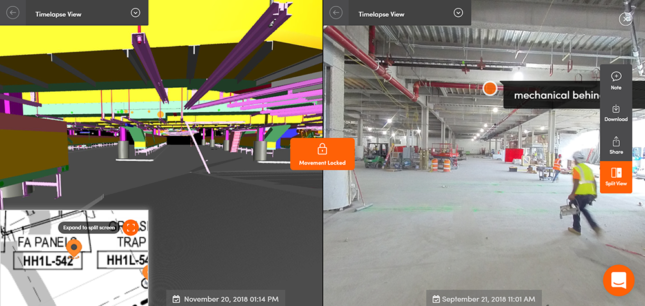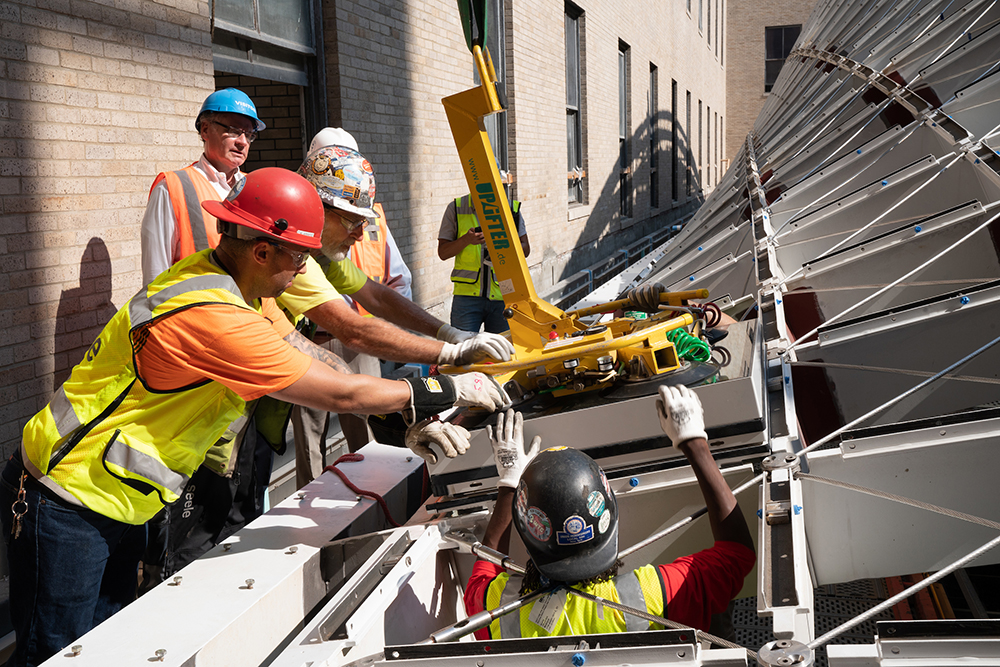The Swedish multinational construction and development company Skanska is responsible for many of the world’s biggest building projects. Right now in New York City alone, it is overseeing two massive infrastructural and architectural undertakings: The Moynihan Train Hall and the LaGuardia Terminal B redevelopment. The design and construction of these projects are being reshaped by the latest technology, particularly when it comes to “reality capture”—laser scanning, drones, 360 photography, virtual reality, and other technologies that are all becoming powerful, scalable, affordable, and interoperable. AN and Tech+ Expo spoke with Skanska’s Tony Colonna, Senior Vice President of Innovative Construction Solutions and Albert Zulps, Regional Director, Virtual Design and Construction to get their insight into how technology is shaping projects today.
Skanska’s 3D laser scanning has been especially useful on projects like the Moynihan Train Hall where there is existing construction. “At Moynihan, we went down into the catacombs, into the tunnels below, the train tracks below,” explained Zulps. “Getting access through Amtrak is limited to weekends, after hours, late at night. To bring all the subcontractors and people that have an interest will be putting systems in there eventually, it is pretty difficult.”
Instead of trying to cram everyone underground at inconvenient hours and to mitigate problems of limited access, Skanska 3D scanned the entire job site and shared between subcontractors, architects, engineers, and others the resulting 3D model that could be imported into software like Revit and Navisworks. This interoperability and ease of use, along with significantly reduced cost, have turned laser scanning from a pricey gimmick into an almost necessary tool. “There’s a right time and place for technology, and both Moynihan and La Guardia are benefited by that,” said Zulps.
“These subcontractors—if they didn’t have a scan, they would have to go down individually on their own to these different spaces, take measurements, make their own assumptions,” he said. “This gives them that information, and it gives it to them on day one. There’s no one or two weeks of doing pipe measurements and drawings to figure out what you’re doing. And that actually allows you to compress the schedule a bit.”
Laser scanning existing structures helps the design and construction teams evaluate inaccuracies in historic plans, as well as account for any shifts that might have happened in the intervening years. In the case of Moynihan Train Hall, Colonna said: “We were going gut it, bring it down to its bones, and then refit out. The plans that the architects were using were not actually what was there. So once we stripped it down, we went in and we did a three-dimensional laser scan, we put that into a model, and then when you overlay that with models that the architects had, you could see the differences in some of the structures. Some of the columns weren’t where they thought they were.”
“There’s a lot of trusses and beams and complex girders that are built 100 years ago, and they are very complex,” Zulps explained. “I don’t know where the original drawings came from how the architects originally formulated their assumptions-but some of the assumptions are wrong.” Sometimes there are pleasant surprises—beams that would’ve gotten in the way but were never built, but at other times laser scanning can help unveil structural issues early on so that architects and structural engineers can collaboratively adapt beforehand, rather than after an unfortunate discovery during the building process. They can also mark “hotspots” on the 3D models, Colonna said, allowing everyone to notice slight differences like tilts on historic walls.

“What I think is exciting is when technologies overlap,” said Zulps of all the new reality capture technology Skanska’s been using. The scans can also be combined with other technology, like 360 photographs, to create hyper-realistic walkthroughs. “Just a few people go down into the train platform with a laser scanner, capture all those conditions, and then share that point cloud and those 360 photos that it takes with all the subcontractors, architects, engineers, all people to test against their assumptions and also use for their background,” explained Zulps. “We’re giving them a virtual walkthrough. We’re giving them the laser scan to walk through and query dimensions. It saves having to get out a lighter, it saves having to book for the time with Amtrak to get down there or the Port Authority. On a project like a renovation when you have to go through an operating train station, laser scanning is just amazing.”
Zulps went on: “We’re making sure the models are available to people in the field. When people ultimately put the buildings together, you have to understand what they’re doing and have clear instructions, and we want to leverage the models we use during coordination. We’re delivering those models on iPads to the subcontractors and our supers.” Now instead of everyone having their own in-house models or drawings, everyone working on a project can coordinate on a model and real time. “Getting that information out into the field is a small thing, but it makes a big difference.”
Though primarily used on retrofits and renovations, laser scanning has also come in handy on new construction, such as the project at LaGuardia. One use is quality control, said Albert. “You do the laser scan to make sure that before you go too far that the foundation is in the right place, for instance. And there have been times on projects where a surveyor might’ve made a mistake or there’s translation error or things were changed and they weren’t caught. So before you go too far down that path, it’s good to catch those errors.”
It can also be a good way to prepare for future steps in the construction process. “We had a central utility plant with a bridge going from a concourse to a head house, and we needed temporarily to put caps on top or pour concrete on top of where those columns were, knowing that in the future, we’d have to open the concrete up and then tie the steel in when that bridge was built,” recalled Zulps. They built laser scanning into their construction process so that “later when the surveyor said, ‘What are we gonna do? We have to break the concrete before we know where to put the new steel.’ One hundred percent, we were like, ‘Don’t worry about it. We did a laser scan.’”
The possibilities are still being explored. “We’ve also used the technology even just for maintenance after the buildings are done,” said Colonna. “There are just a tremendous amount of opportunities.”
For more on the latest in AEC technology and for information about the upcoming TECH+ conference, visit techplusexpo.com/nyc/.
